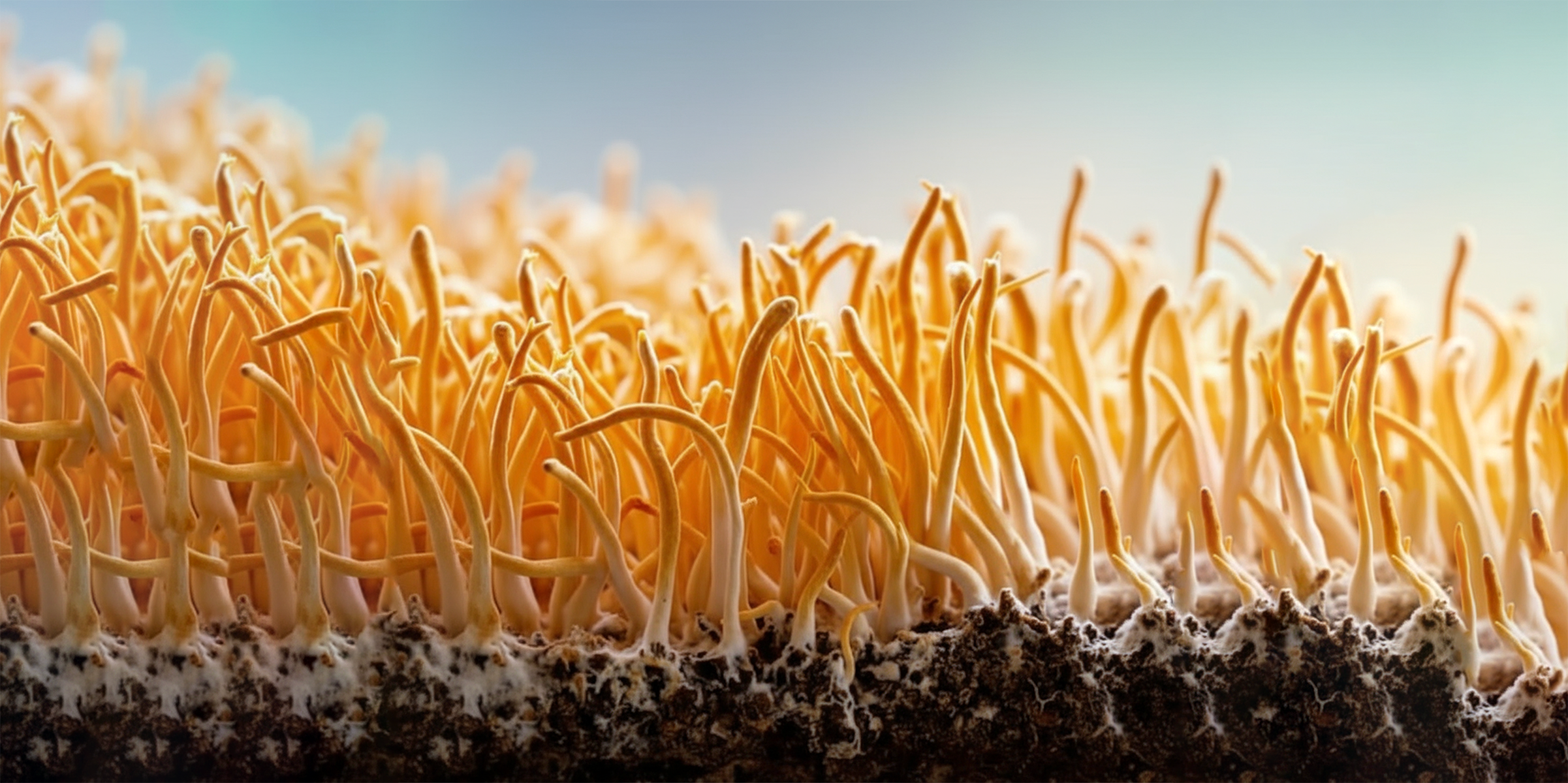Deep in the highlands of Tibet, at altitudes above 3,500 metres, one of nature's most fascinating phenomena occurs. Cordyceps sinensis, known as the "caterpillar fungus," begins its life cycle as a parasitic fungus that infects ghost moth caterpillars. The fungus gradually consumes its host, eventually sprouting a fingerlike fruiting body from the mummified caterpillar's head. This bizarre natural process, combined with the challenging high-altitude environment where it grows, has made natural Cordyceps one of the most expensive medicinal fungi in the world.
For centuries, traditional Chinese medicine has revered Cordyceps sinensis, often called the "caterpillar fungus," for its ability to "invigorate the lung and nourish the kidney" and boost overall vitality (Dong & Yao, 2008). While wild Cordyceps remains highly prized, modern science has developed sophisticated cultivation methods that allow the fungus to be grown in controlled laboratory conditions on nutrient-rich media, making its benefits more widely accessible.
The Olympic Controversy
The global spotlight found Cordyceps in 1993 when China's Wang Junxia, Wang Yuan, and Qu Yunxia shattered multiple world records at the Chinese National Games in Beijing. The women broke the 10,000-metre record by an astounding 42 seconds, with Wang Junxia running the 3,000 metres in a time that was nearly five seconds faster than the previous world record (Chen et al., 2013).
When their coach Ma Junren attributed these extraordinary performances partly to a tonic made from Cordyceps sinensis, controversy erupted. While the athletes tested negative for banned substances, the international sporting community remained sceptical of such dramatic improvements in performance. However, this controversy sparked intense scientific interest in Cordyceps, leading to decades of research into its potential performance-enhancing properties (Zhou et al., 2009).
Just as beetroot juice has become a staple in many athletes' nutrition plans due to its proven ability to enhance blood flow and oxygen delivery, Cordyceps works through remarkably similar pathways. Research shows that Cordyceps sinensis promotes vasodilation — the widening of blood vessels — which allows for increased blood flow and oxygen delivery to active muscles (Chiou et al., 2000). This natural process mirrors the well-documented effects of beetroot juice's nitrates, helping athletes maintain higher intensity levels during training and competition.
Modern Cultivation and Quality
Today, the wild Cordyceps can command prices exceeding $20,000 per kilogram. However, thanks to carefully controlled laboratory cultivation techniques, the production of high-quality Cordyceps sinensis mycelium can happen at a fraction of the cost.
QED Energy uses extracts from premium cultivated C. sinensis grown under strict quality control conditions, ensuring consistent potency and purity while preserving the delicate ecosystem where wild Cordyceps grows.
The Science Behind the Cordyceps
Scientific research has shown that Cordyceps sinensis contains several bioactive compounds that may contribute to increased energy and enhanced physical performance. These include cordycepin and adenosine, which have been shown to improve oxygen utilisation and blood flow, and complex polysaccharides that support immune function and reduce fatigue (Zhou et al., 2009).
Clinical studies have demonstrated promising results. Research on healthy older adults found that Cordyceps supplementation significantly improved maximum oxygen consumption (VO2 max) and ventilatory threshold (Chen et al., 2010). In a separate study, participants taking Cordyceps showed improved exercise tolerance and delayed onset of fatigue (Hirsch et al., 2017).
Cordyceps Sinensis vs Militaris: Why Quality Matters
While both Cordyceps sinensis and Cordyceps militaris share some similar properties, there are crucial differences. Although C. militaris contains similar bioactive compounds and is easier to cultivate (Kim & Yun, 2005), it cannot be used in supplements within the EU due to novel food regulations and safety concerns around standardisation and production methods.
Research indicates that C. sinensis may yield unique beneficial compounds not found in other Cordyceps species. For example, studies have identified novel compounds called cordysinins (A-E) exclusive to natural C. sinensis that demonstrate anti-inflammatory properties (Yang et al., 2011).
The QED Energy Difference
Our energy supplement combines pure Cordyceps sinensis with other scientifically-validated ingredients to create a comprehensive energy support formula. Clinical research supports the traditional uses of Cordyceps, with studies showing:
- Improved aerobic capacity and oxygen utilization (Chen et al., 2010)
- Enhanced exercise performance and reduced fatigue (Koh et al., 2003)
- Antioxidant properties that may aid recovery (Yamaguchi et al., 2000)
Unlike stimulant-based energy products, QED Energy works with your body's natural systems to promote sustainable energy production and utilisation.
How to Use
For optimal results, take QED Energy daily with food, preferably in the morning. Research suggests that consistent supplementation over several weeks provides the most significant benefits, as the adaptogenic properties of Cordyceps slowly build up constant levels and start to support your body's natural energy systems (Chen et al., 2010).
Frequently Asked Questions
Is Cordyceps sinensis safe to take daily?
Yes, research indicates that Cordyceps sinensis is safe for daily consumption. Clinical studies have shown no significant adverse effects at recommended dosages (Chen et al., 2010). However, as with any supplement, consult your healthcare provider before starting, especially if you have underlying medical conditions.
How long until I notice results with QED Energy?
While individual responses vary, most users report noticeable improvements in energy levels within 1-2 weeks of consistent use. Clinical studies typically show significant improvements in exercise performance and energy levels after 3-4 weeks of regular supplementation (Hirsch et al., 2017).
Can I take QED Energy with other supplements?
QED Energy can be safely combined with most supplements. The natural compounds in Cordyceps sinensis work through different pathways than typical stimulants. However, always consult with a healthcare provider about your specific supplement regime.

